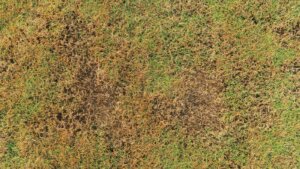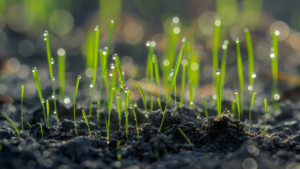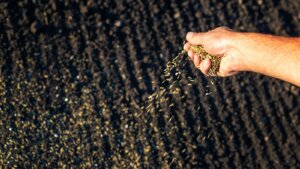Irrigation systems are vital for maintaining a vibrant lawn, and a well-installed sprinkler system is critical. This guide provides essential insights into setting up an effective irrigation system. You’ll learn about components like PVC pipes, valve boxes, tees, manifolds, clamps, nozzles, and controllers. We’ll cover the importance of psi, gpm, and using the right tools like shovels and pipe cutters.
While this guide offers a DIY perspective, remember that specialists like Terra Lawn Care bring expertise and precision to ensure your system is efficient, from the main line setup to the intricate placement of zone valves and sod.
Understanding Sprinkler Systems and Their Components
Sprinkler systems are a vital solution for maintaining a lush, healthy lawn. Key components include pipes, valves, and sprinkler heads, each playing a role in delivering water efficiently and evenly to your property.
Critical Components for Sprinkler System Installation:
- In-Ground Water System: Utilizes buried pipes and sprinkler heads.
- Pop-Up Sprinkler & Rain Bird: Types of sprinkler heads that provide varied spray patterns.
- Funny Pipe: Flexible pipe for connecting sprinkler heads to the main line.
- Water Meter & Pressure Gauge: Essential for measuring water use and pressure.
- PVC Pipe: Commonly used pipe material, often in 1-inch or 40 schedule sizes.
- Shut-Off Valve: Controls the water supply to the system.
- Trenching Tools: Shovels and trenchers for digging installation paths.
- Permits and Compliance: Check with your local building department for necessary licenses and guidelines.
- Adjustable Components: Valves, sprinklers, and controllers for customized watering schedules.
- Regular Maintenance: It is necessary to check for leaks and ensure optimal function.
Each of these elements plays a crucial part in successfully installing and operating a sprinkler system, ensuring efficient water usage and a well-maintained lawn.
Selecting the Right Pipes and Fittings
Choosing the suitable materials, like PVC or polyethylene pipe, and the correct fittings is crucial. In Collegeville, PA, consider the local climate and soil type when selecting your lines and fittings. Proper material selection ensures longevity and efficiency.
Preparing for Installation: Checking Utilities and Water Pressure
Before embarking on installing your sprinkler system, it’s essential to prepare thoroughly. It includes checking for underground utilities and measuring water pressure to ensure a smooth and safe installation process.
Installation Preparation Checklist
- Check for Underground Utilities: Contact local services to mark underground sewer lines, water pipes, or other utilities.
- Measure Water Pressure: Use a pressure gauge on your home’s outdoor water source.
- Determine Main Water Line Size: This helps select the correct pipe size, typically Schedule 40 PVC.
- Plan the Layout: Create a detailed plan, marking where to dig trenches (at least 10 feet apart and 12 inches deep) and where sprinkler heads will go.
- Acquire Necessary Tools: Rent a trencher for large areas, and use a shovel for precise digging.
- Purchase Materials: Your shopping list should include PVC or funny pipe, swing pipe, fittings (like 90-degree elbows), and sprinkler heads.
- Consider Water Flow: Understand your home water system’s gallons-per-minute capacity to adjust the watering schedule.
- Backfill and Finish: Backfill trenches and make final adjustments once installation is done.
For complex systems or if you’re unsure, consulting with specialists like Terra Lawn Care can save water and ensure a professional finish.
Laying Out Your Sprinkler System
When planning your sprinkler system layout, it’s essential to consider each area’s specific watering needs. Map out your lawn, noting the location of plants with similar water requirements. This zoning method helps in efficient water usage and prevents over or under-watering.
Remember to mark the location for each sprinkler head, considering factors like sun exposure and the type of vegetation to optimize the irrigation coverage.
Digging Trenches and Installing Pipes
Once you’ve marked the layout, it’s time to dig trenches for the pipes. Remember, the trenches should be deep enough to protect the pipes from freezing temperatures and mechanical damage. Use a tee fitting or splice connections for a secure setup when installing the pipes.
Ensure the pipes have a slight slope to assist with drainage and prevent water stagnation.
Installing Sprinkler Heads and Valves
After laying the pipes, install the sprinkler heads at strategic locations to ensure complete lawn coverage. Use adjustable heads like “funny pipe” for areas with irregular shapes. Install valves at strategic points to control water flow to different zones. These valves, managed by a timer, help regulate the watering schedule based on each zone’s requirements.
Connecting to the Water Supply and Backflow Prevention
Connect the system to your home’s water supply line, ensuring a seamless and leak-free connection. Install a backflow preventer to protect your water supply from potential contamination.
This device is crucial, especially where the system is connected directly to the home water supply.
Finalizing Installation: Testing and Adjustments
Once everything is connected, turn the water on and inspect the system for leaks. Adjust the sprinkler heads to ensure they cover the intended areas. Check the flow rate and adjust the timer accordingly to ensure efficient watering. After making all necessary adjustments, fill the trenches and backfill around the sprinkler heads.
Maintenance and Winterization Tips
To maintain your system, routinely inspect and clean sprinkler heads, especially if you notice a change in water pressure or distribution. Drain the system to prevent pipe freeze and breakage in preparation for Collegeville’s winter.
For systems with “funny pipe” or swing pipe, ensure they’re adequately drained, as these flexible pipes are more susceptible to damage. Turn off the timer during the off-season to save water and energy.
Mastering Your Lawn’s Irrigation in Collegeville, PA
Installing a sprinkler system is a smart investment for maintaining a vibrant lawn in Collegeville, PA. To help you on this journey, here’s a recap of the crucial steps:
- Designing Your System: Plan your layout considering each zone’s needs.
- Installation Essentials: Use quality materials and tools from local hardware stores.
- Practical Tips: Dig trenches properly, carefully install each component, and ensure leak-free connections.
- Regular Maintenance: Check for clogged sprinkler heads and adjust your control valve.
Though this guide provides a solid foundation, partnering with professionals like Terra Lawn Care ensures your system is optimized for your specific landscape needs, saving water and maintaining the beauty of your lawn.






